Medieval Women Saints
There is very little teaching done on women who lived during the Middle Ages. This is not only true in general society but also in church. It is a shame because the women who lived 5 to 10 centuries ago did wonderful work in the Kingdom of God. They served the poor, comforted the mourning, raised godly families, and much more. Many even left us written accounts of their activities. If we did not have these stories we would not know as much about everyday life during Medieval times.
The material in the books covered in these reviews spans about ten centuries – from 500 AD to 1500 AD. Three of the books contain biographies. One book, Crown & Veil, gives us the background to life in the female monasteries. If you ever wondered what God’s saints were doing during this thousand-year time period, these books will fascinate and enlighten you.
— Hamburger, Jeffrey F., and Marti, Susan, Editors, Crown & Veil: Female Monasticism from the Fifth to the Fifteenth Centuries, (Columbia University Press, New York, 2008).
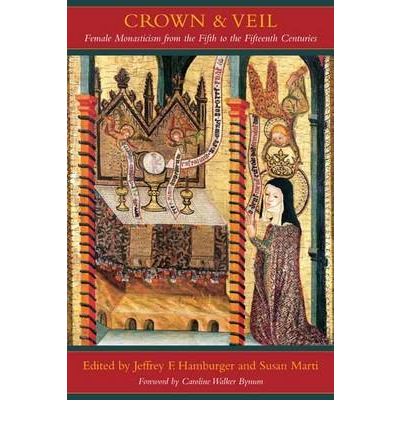 When most people picture a convent the image they get is a quiet, secluded, austere building far away from civilization. While some convents were purposefully more secluded, most were communities of women who were able to engage in activities otherwise denied them both inside and outside of the cloister.
When most people picture a convent the image they get is a quiet, secluded, austere building far away from civilization. While some convents were purposefully more secluded, most were communities of women who were able to engage in activities otherwise denied them both inside and outside of the cloister.
Convents were not the bleak places we often imagine them to be. Women went to convents to get an education as well as to fellowship and pray with other women. Many “nuns” wrote books, poetry, and music. Others painted and engaged in other facets of art. Most did not reside like hermits in their cloisters but moved out into the surrounding community with food and clothing and medicine and love for the poor and needy. Some abbesses were renowned for their Biblical knowledge and wisdom and their spiritual care of others in the convent and in the surrounding community.
This book is a series of articles by different authors, each telling of the different aspects of female monastic life. It is thrilling to see what sort of life Christian women lived during the Middle Ages. You won’t be disappointed!
— Dronke, Peter, Women Writers of the Middle Ages, (Cambridge University Press, Cambridge, 1984).
This book actually covers from 300 AD to around 1300 AD. That is because Perpetua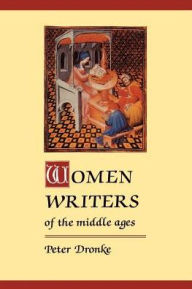 is included (see my post on this site – August, 2010). Perpetua is considered one of the earliest women Christian writers. Perpetua and her slave Felicitas were martyred on March 7, 203 AD. Perpetua wrote an account of her life that has been preserved for us. Peter Dronke continues moving through the Middle Ages telling the stories of Dhuoda, Hrotsvitha, Heloise, Hildegard of Bingen and Marguerite Porete, focusing on their writings. He also includes the poetry by women of the eleventh and twelfth centuries.
is included (see my post on this site – August, 2010). Perpetua is considered one of the earliest women Christian writers. Perpetua and her slave Felicitas were martyred on March 7, 203 AD. Perpetua wrote an account of her life that has been preserved for us. Peter Dronke continues moving through the Middle Ages telling the stories of Dhuoda, Hrotsvitha, Heloise, Hildegard of Bingen and Marguerite Porete, focusing on their writings. He also includes the poetry by women of the eleventh and twelfth centuries.
The book is written from a technical standpoint, but it is still fascinating because Dronke emphasizes the women’s personal testimonies. Peter Dronke has shown what skilled writers women are. It is too bad that their stories are so neglected. Though a little on the “dry” side I think you will be amazed and uplifted by these accounts.
— Mayeski, Marie Anne, Dhuoda: Ninth Century Mother and Theologian, (The University of Scranton Press, Scranton, 1996).
One of the women mentioned in Peter Dronke’s book as an exceptional female writer 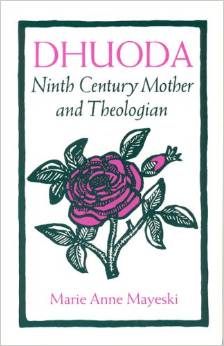 of the Middle Ages was Dhuoda. Dhuoda is very well known among scholars of literature. Marie Anne Mayeski has given the world a gift in her book about Dhuoda’s life. We know so little about women in the Middle Ages. This book whets our appetites for more.
of the Middle Ages was Dhuoda. Dhuoda is very well known among scholars of literature. Marie Anne Mayeski has given the world a gift in her book about Dhuoda’s life. We know so little about women in the Middle Ages. This book whets our appetites for more.
Admittedly, not much is known about Dhuoda except through her writings, but we do have the history of her times and her family. Through her writing we can deduce what a dedicated mother Dhuoda was. One of her books (published in 843 AD) was copied for many years and is in print today – Liber Manualis. Dhuoda intended this book to be a manual for the personal growth and edification of her son William.
Dhuoda’s book contains teaching from the Scriptures. Her Bible knowledge and wisdom, coming from years of study, proves that Dhuoda was a lay theologian.
We can be thankful that Dhuoda left us her writings. Her advice to her son on moral behavior is timeless. Dhuoda is a shining example of a woman who loved God above all and spent her time studying about Him to get to know Him better and to pass on that knowledge to others.
Marie Anne Mayeski is a good story teller. You will not find this book dry! You will appreciate how Mayeski weaves Dhuoda’s learning and writing with history and biography. For me, it was a book hard to put down. I think you will enjoy it.
— McNamara, Jo Ann, Editor and Translator, Halborg, John E. and Whatley, E. Gordon, Editors, Sainted Women of the Dark Ages, (Duke University Press, London, 1992).
The book contains the stories of 18 Frankish women (12 abbesses, 3 queens, and other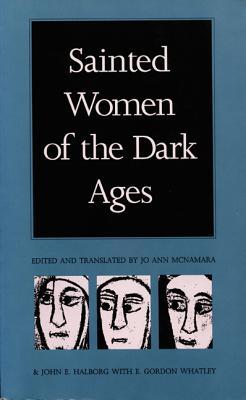 devout widows and wise women) who lived during the so-called Dark Ages – the time period of the sixth and seventh centuries. This time period covers from the fall of the Roman Empire until the rise of Charlemagne’s family.
devout widows and wise women) who lived during the so-called Dark Ages – the time period of the sixth and seventh centuries. This time period covers from the fall of the Roman Empire until the rise of Charlemagne’s family.
When the stories begin, we find the women living in the land that was known as Roman Gaul. The Christians were the survivors of the wars. Gradually they formed their own kingdoms of Neustria, Burgundy, and Austrasia. The people in this land would come to be called the “Franks”.
Each chapter in the book gives the historical background of the saint. Then the editors include information gained from historical documents. Many of the stories will contain information that is strange sounding if you are not a Roman Catholic. I grew up with stories of the miracles that surrounded women saints. The editors of this book put their own commentary in the footnotes for you. How much is myth or legend? I believe that God does do miracles and heal people. I am sure that the prayers of these saintly women had some effect. Even if some of the legends are just that – legends – they are interesting stories. Every legend contains a kernel of truth.
I think you will still enjoy reading this book. Again, it is proof that God was at work in the so-called Dark Ages!
— Deen, Edith, Great Women of the Christian Faith, (Christian Herald Books, Chappaqua, New York, 1959).
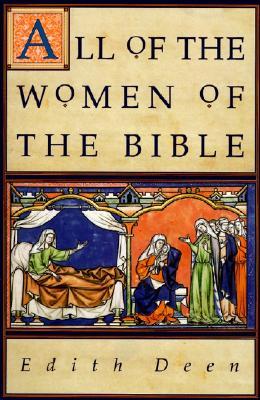 Edith Deen has also written a companion book that I think you will enjoy, All of the Women of the Bible.
Edith Deen has also written a companion book that I think you will enjoy, All of the Women of the Bible.
In this book on great Christian women in history, you will encounter the stories of 45 spiritual leaders and 76 other women from around the world. The stories include women from many denominations. 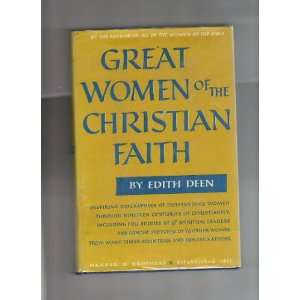 Theological controversies are put aside. The important thing about each woman is that she loves Jesus and that her life shows how she served God faithfully.
Theological controversies are put aside. The important thing about each woman is that she loves Jesus and that her life shows how she served God faithfully.
You will be inspired as you read the stories of martyrs, mothers, wives, and even political leaders. The stories span the last twenty centuries (at least up until the writing of the book in 1959).
Of special interest for this review is the fact that Edith Deen relates the stories of more than a dozen women from the Middle Ages. Edith Deen has a great gift as a storyteller and I think you will not find this book to be as “dry” as the others in this review. It is a great book to share with your daughters and other Christian women who are interested in stories.
Both of Edith Deen’s books could be used to good effect in a Bible Study or Sunday School. Women will love the stories!

